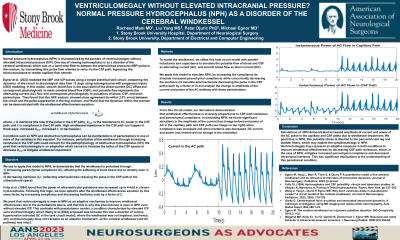Ventriculomegaly Without Elevated Intracranial Pressure? Normal Pressure Hydrocephalus as a Disorder of the Cerebral Windkessel
Friday, April 21, 2023

.jpg)
Racheed M. Mani, MD
Resident Physician
Stony Brook University Hospital, Department of Neurological Surgery
Lake Grove, New York, United States
ePoster Presenter(s)
Introduction: Normal pressure hydrocephalus (NPH) is characterized by the paradox of ventriculomegaly without elevated intracranial pressure. One way of viewing hydrocephalus is as a disorder of the cerebral windkessel, which acts as a band-stop filter to dampen the arterial blood pressure (ABP) pulse in the cranium, by transmitting this pulse from arteries to veins via the CSF path, bypassing the microvasculature to render capillary flow smooth. We propose that the windkessel is perturbed through increasing resistance in the CSF path (in obstructive hydrocephalus (OH)), or by increasing parenchymal compliance (in NPH via softening of brain tissue due to atrophy). We propose a circuit model to simulate the cerebral windkessel and perturbations therein to replicate the dynamics of NPH.
Methods: To model the windkessel, we utilize a tank circuit with parallel inductance and capacitance to simulate the pulsatile flow of blood and CSF as alternating current (AC), and smooth flow as direct current (DC), and increase the resistance and compliance within this circuit to simulate OH and NPH, respectively.
Results: From this circuit model, our derivations demonstrate that windkessel effectiveness is inversely proportional to CSF path resistance and parenchymal compliance. In simulating OH and NPH, we found significant elevations in the amplitude and power of AC in the capillary path when resistance and compliance were increased.
Conclusion : Simulations of both NPH and OH demonstrated increased amplitude and power of the AC pulse in the capillary path due to windkessel impairment. We posit that, in NPH, this pulsatile stress is diverted to the periventricular leg and bladder fibers, which may explain the symptomatology in NPH. Ventriculomegaly may represent an adaptive response in both conditions to improve windkessel effectiveness by decreasing CSF path resistance, which, in the case of NPH, mitigates increased parenchymal compliance. This has significant implications in the understanding of this paradoxical condition.
Methods: To model the windkessel, we utilize a tank circuit with parallel inductance and capacitance to simulate the pulsatile flow of blood and CSF as alternating current (AC), and smooth flow as direct current (DC), and increase the resistance and compliance within this circuit to simulate OH and NPH, respectively.
Results: From this circuit model, our derivations demonstrate that windkessel effectiveness is inversely proportional to CSF path resistance and parenchymal compliance. In simulating OH and NPH, we found significant elevations in the amplitude and power of AC in the capillary path when resistance and compliance were increased.
Conclusion : Simulations of both NPH and OH demonstrated increased amplitude and power of the AC pulse in the capillary path due to windkessel impairment. We posit that, in NPH, this pulsatile stress is diverted to the periventricular leg and bladder fibers, which may explain the symptomatology in NPH. Ventriculomegaly may represent an adaptive response in both conditions to improve windkessel effectiveness by decreasing CSF path resistance, which, in the case of NPH, mitigates increased parenchymal compliance. This has significant implications in the understanding of this paradoxical condition.
